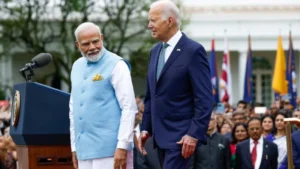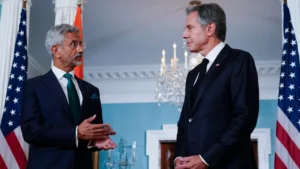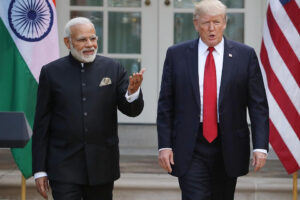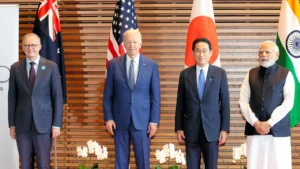Articles
This chapter was made possible through a grant from the Hindu American Foundation.
In 2021, when President Biden took office, the US-India relationship was riding on the positive momentum created by successive US presidents since President George W Bush. Over the four years of the Biden administration, with few positive developments and several other tensions, the partnership was stress-tested across domains. For watchers of the US-India bilateral partnership, the Biden administration’s denouement vis-a-vis the partnership with India was disappointing and underwhelming. While several key supply chain diversification initiatives materialized, issues surrounding India’s position toward Russia—in the aftermath of the latter’s invasion of Ukraine—its alleged involvement in the killing of a Khalistan separatist and lastly Washington’s position on the interim government in Bangladesh highlighted the divergences between the two democracies. For the US-India partnership, President Biden’s term in office could be described as one that alienated an already allyship/treaty-averse India, pushing it further into groupings such as BRICS and other emerging non-Western multilateral institutions. The last eight months were no different. Nonetheless, domestic political developments in both India and the US could potentially set the stage for a recourse in the spiraling US-India bilateral partnership.
Election Polls ≠ Election Results
Around the world, pollsters are increasingly having a hard time deciphering the exact outcome of elections in boisterous democracies. In both India and the US, elections polls predicting results were off by significant margins, particularly in India. In India, elections last a few months, with different parts of the country going to the polls one after the other. The election contest that began in April 2024 ended in June 2024. Most pollsters had predicted a sweep for the ruling Bhartiya Janata Party and return of Prime Minister Narendra Modi for a third term in office.

Figure 1 US President Joe Biden hailed US-India ties, while rolling out the pomp and pageantry for visiting Prime Minister Narendra Modi on Jun. 22, 2023. Photo: Getty Images
The pollsters were partly correct. Modi returned for a third term in office. However, unlike the first or second terms, it would not be with an absolute majority in the parliament. For the first time the Modi government turned to its coalition partners in the north and southeast to form a government. Some strategic analysts deemed it a weakening of Modi’s position. Opinions are mixed as to whether the opposition truly made inroads or not, since the leading opposition party, Indian National Congress, secured only 99 seats out of the available 543, versus the BJP’s 240. With 272 seats required to form a government, BJP’s path to 7 Lok Kalyan Marg (the PM’s office) was easier with its partners in the northern state of Bihar and southeastern state of Andhra Pradesh sweeping the polls, bringing its seat tally to 293. The unexpected election results caused an initial panic in the Indian stock markets. However, things settled soon after when speculation and rumors were put to rest, signaling policy continuity in Modi 3.0.
For Washington, Modi 3.0 signals macroeconomic stability and policy continuity to continue cooperation in critical and emerging technologies, supply chain diversification and defense and security cooperation. Unlike coalition partners from past Congress governments, the BJP’s coalition does not include members of the Indian far left, such as Communist Party of India (CPI) and Communist Party of India (Marxist), also known as CPI-M. These two parties have opposed several initiatives aimed at strengthening US-India relations. In complete contrast, BJP’s coalition partner in the south, the Telugu Desam Party led by Chandrababu Naidu, has consistently advocated for stronger US-India ties. In fact, the chief minister in his terms in office has brought in significant American investment to Hyderabad. The election results in the US were no different. Opinion polls predicted a close and tight race between Vice President Kamala Harris and Donald Trump, incumbent Joe Biden’s predecessor. On Nov. 5, the 45th president won a decisive victory, claiming all swing states from Pennsylvania in the east to Arizona in the southwest, also bringing down what was known as a blue wall for the Democrats in Midwest. While reactions to Trump’s victory were largely mixed in the Indo-Pacific, New Delhi was among the few that was ecstatic with the news that the former president will return to the Oval Office in January 2025.
There are multiple reasons for the Indian strategic community’s celebration. In the first Trump administration, there were multiple policy convergences. From defense officials overtly supporting India in its clash with China at the border, to a revitalized and strengthened Quadrilateral Security Dialogue (“Quad”), increased security cooperation between the two nations, supplemented by Modi-Trump bromance, the partnership between the world’s largest and oldest democracies was strengthened.
In complete contrast to these developments, the Biden administration postponed and canceled Quad meetings, pressured India on its non-aligned position on Russia’s invasion of Ukraine, handled allegations surrounding India’s involvement in the plot to kill a Sikh separatist (labeled a terrorist in India) in a haphazard way by leaking intelligence to the press and validated an interim government in Bangladesh that ousted the former prime minister Sheikh Hasina through violent protests.
Strategic analysts believe Trump’s transactional foreign policy coupled with his nomination of several champions of the US-India partnership will lead to a smooth or at least smoother ride in his second administration. From the leader of the India caucus, Michael Waltz, as national security advisor, to Marco Rubio—the Florida senator who advocated for elevating the US-India partnership to a defense treaty level, on par with Japan, Korea, Israel, and NATO—as secretary of state to the former Rep. Tulsi Gabbard of Hawaii as director of national intelligence, several key nominations indicate a strong support for US-India partnership and increased synergies between Trump 2.0 and Modi 3.0.
Granted, trade and commercial ties between the two could experience turbulence given the president-elect’s penchant for using tariffs and trade barriers as leverage against both allies and partners. India was not spared his first administration and with the ballooning trade deficit between the two, it likely won’t be spared in his second administration.
Nonetheless, a major headache for Delhi may be solved—Washington’s pressure to abandon Russia, severing its ties with its Cold-War era- and time-tested partner. A key bone of contention for the Biden administration since Russia’s invasion of Ukraine in February 2022 may not be one for the Trump administration.
Cold-War Era Differences are Here to Stay
In the months leading up to the election in the US, Hindu priests in New Delhi were organizing prayers for Trump’s victory. This phenomenon reflected overlapping priorities between many in India and the Trump administration. It is not news that strengthening the bilateral partnership between the US and India is a bipartisan effort in Washington DC. However, in the months between May and December, there was increased skepticism in the direction of the partnership, both in Washington and New Delhi. Despite making significant progress in expanding the scope of the partnership across traditional and non-traditional security domains, allegations surrounding the Indian government’s involvement in a plot to kill a separatist, particularly by the judiciary in the US, did not bode well for the partnership. The US District Court for Southern District of New York named the government of India, National Security Advisor Ajit Doval, and former Secretary of the Research and Analysis Wing Samant Goel in a summons right before Modi’s visit to the US. While the summons came in response to a civil lawsuit filed by a Khalistan separatist, the optics of a court in New York summoning their nations NSA and former intelligence chief reinforced Indians’ concerns of the West’s overreaching arm. The India government dismissed the summons as “unwarranted and unsubstantiated imputations.”

Figure 2 Secretary of State Antony Blinken speaks with Indian External Affairs Minister Subrahmanyam Jaishankar, Thursday, Sept. 28, 2023, at the State Department in Washington. Photo: AP Photo/Stephanie Scarbrough
In an ironic turn of events, Modi and Indian External Affairs Minister Subramanyam Jaishankar were in Washington celebrating the progress of iCET, a brainchild of the Indian NSA. These ironies reflect a broader theme in the US-India partnership. While challenges in the Indo-Pacific, such as China’s aggression, have served as a catalyst for increased cooperation between the two democracies across various domains, Cold-War era allegiances and ideological fealties continue to hamper the relationship.
Not to mention that the divergences have raised doubts about Washington’s seriousness toward supporting India in the Indo-Pacific region. Delays in shipment of the Apache helicopters ordered by India and slow progress on other fronts have not helped the US-India partnership. While the Biden administration positioned India as a key “friendly shore” in the diversification of key supply chains, initiated sector specific programs such as iCET, including with partners such as South Korea, political concerns and these distractions have held back the partnership from realizing its full potential.
One of the major contentions of the Cold War were the United States and India’s partnerships with their adversaries. India had a defense partnership with the Soviet Union while the US supported Pakistan. Plus, in former secretary of state, Henry Kissinger’s attempts at establishing a rapprochement between the US and China, he further isolated India. US involvement in South Asia has not supported India but often challenged its hegemony or supposed sphere of influence. In the months between May and December 2024, New Delhi found its sphere of influence threatened with the friendly Prime Minister Sheikh Hasina ousted by violent protests. While she has sought refuge in India, among the first governments to recognize the new unelected leader of Bangladesh—with an official title of advisor—Muhammad Yunus, was the United States.
Signaling a different approach, at the end of October, shortly before the election, Trump tweeted: “I strongly condemn the barbaric violence against Hindus, Christians, and other minorities who are getting attacked and looted by mobs in Bangladesh, which remains in a total state of chaos. It would have never happened on my watch.”

Figure 3 President Donald Trump with Indian Prime Minister Narendra Modi in 2017. Photo: Mark Wilson/Getty Images
From the Cold War era to present day, sections within the Washington establishment continue to undermine New Delhi’s influence in the region. The unfolding crisis in Bangladesh add to an already unstable South Asia. For New Delhi, the civil strife in its northeastern state of Manipur and the unfolding situation in Bangladesh increase volatility in its neighborhood. With China actively trying to consolidate footholds in Pakistan, Maldives, Sri Lanka, Nepal, and elsewhere, and Bangladesh turning increasingly hostile to Indian interests and religious minorities, especially Hindus, India’s neighborhood has turned challenging over the last few years. These developments highlight stress points in New Delhi and Washington’s divergent approaches to the Indian Ocean and the broader Indo-Pacific. In mid-November, US and India held the inaugural Indian Ocean dialogue to discuss security issues affecting the region. While there were several high-level exchanges between Modi and Biden, and across various levels of the government, including in track 1 dialogues such as the recently inaugurated Indian Ocean dialogue, talks and walks have been diametrically different on several instances.
The chaos in India’s neighborhood, postponed and canceled Quad meetings in 2023 and in early 2024, and friction over the alleged plot to kill a separatist may have prompted an expedited rapprochement with the PRC. In the last six months, New Delhi and Beijing’s diplomatic efforts at resetting ties to pre-Galwan levels took shape. Both sides have agreed to disengage and continue border patrols. On the sidelines of the BRICS summit, both sides agreed to border patrol arrangements and disengage from their earlier offensive stand. The last four years witnessed tense relations between the two, affecting trade and commercial ties and even people-to-people ties with both countries, making travel difficult between the two.
The perceived threat of China was a catalyst for expanded cooperation between the US and India. In the absence of an active threat, and multiple divergences over regional and global issues, the impetus for increased cooperation could wane over time without proper intervention.
Blow Hot, Blow Cold
There were multiple developments signaling expanded cooperation and convergence on interests and even values. For example, the Indian consulates in the US engaged in several sub-national diplomatic efforts highlighting shared values of democracy and equality. In Lansing, Michigan, the Indian Consul General in Chicago, participated in the Annual Indian American Legislative Day at the State Capitol, highlighting the shared democratic values of both countries. Similarly, senior officials from both the US and India signed a Statement of Intent to establish the Gandhi-King Development Foundation named after Mahatma Gandhi and Martin Luther King Jr.

Figure 4 Australian Prime Minister Anthony Albanese, US President Joe Biden, Japanese Prime Minister Fumio Kishida and Indian Prime Minister Narendra Modi pose prior to a Quad meeting last year on May 24, 2023 in Tokyo, Japan. Photo: The Asahi Shimbun/Getty Images
From Indian diplomats organizing a celebration of International Yoga Day in Mississippi State Capitol to American diplomats supporting LGBTQ rights in Pune, India, subnational diplomacy was alive and well—even when diplomacy at the top was strained. For example, in early May, President Biden accused India, China and Japan of being “xenophobic” at a fundraising event for his presidential campaign. In early December, the BJP, Modi’s party at the center, accused the State Department of colluding with billionaires such as George Soros to destabilize the Modi government. Deputy Secretary Kurt Campbell along with senior Indian officials was convening the inaugural US-India Indian Ocean dialogue in November all while India was upset with Washington’s approach to the government in the Indian Ocean neighbor Bangladesh. At the G20 meeting in Rio De Janeiro, Biden expressed support for India’s climate actions. Not long after, the Indian billionaire Gautam Adani, behind India’s Make in India movement to reduce reliance on Chinese solar panels, was accused by the SEC and the district courts in New York of securities fraud and bribery among other charges. These push and pull frictions have not helped the US-India bilateral partnership.
Over the last two decades, the US-India partnership was fostered by all branches of the US government across different administrations. The US-India partnership was among the few partnerships that enjoyed bipartisan support. However, recent accusations by the BJP and frictions in ties since Biden took office, would indicate a shift in the bipartisanship. Members of the Democrat party such as representatives Ilhan Omar (D–Minnesota), Rashida Tlaib (D–Michigan) and Jamaal Bowman (D–New Yorkt) have consistently voiced concerns about the US partnership with India. While initially these were considered fringe, and not shared by the larger Democrat party, alleged actions by the Indian government or the Democrat party itself moving farther left from core ideology, has strained the relationship, raising concerns of the relationship turning a partisan endeavor.
This pull and push dynamic in the relationship has certainly proved to be an impediment to unfettered growth.
Strategic analysts are of the view that the BJP is counting on Trump 2.0 to reset ties. The Indian government if not publicly exuberant, is not anxious as many in Europe and the broader Indo-Pacific seem to be. India’s External Affairs Minister Jaishankar, speaking at a public event, said, “Prime Minister Narendra Modi was among the first three calls, I think, that President (elect) Trump took”…while a lot of countries are nervous about a Trump presidency, India is not among them”
The expectation is understandable. The bromance between the leaders, witnessed at events such as Howdy Modi and Trump’s welcome in India helped stabilize the relationship in Trump’s first term even as the two administrations diverged on trade issues. Minus the jabs at India for its tariffs, Trump has consistently spoken highly of Modi and the Indian government. Multilateral initiatives such as Quad were on much stronger footing in Trump 1.0 and Modi 1.0 than they were under Biden. Nonetheless, the incoming Trump administration may not necessarily have the same priorities as the Biden administration, not just in democracy promotion but in global common interests such as addressing climate change.
One of the key convergences between the Biden and Modi administration was on increasing engagement with G20 countries on global issues such as climate change and environmental protection. In multilateral platforms such as G20 and Quad, the two countries emphasized the need to address climate change and work collectively to promote environmental protection and climate resilience. In such areas where the US under Trump may not have an appetite for increased engagement, such as public good delivery and infrastructure development, New Delhi may have to go alone.
New Delhi Steps in Where Washington Retreats
Trump’s transactional foreign policy that prioritizes zero-sum trade interests over goodwill and greater public good, could leave voids in places that offer little commercial incentive for increased engagement. The Pacific Islands are one such place that hold immense strategic value to the United States but little commercial value, at least relative to the large economies in the Indo-Pacific. While Washington steps up its focus on commercial ties and defense posturing in the Indo-Pacific, New Delhi can stick to its playbook in the Pacific by continuing public goods delivery and supporting the inclusive development of small-island states.
Over the last eight months, India has extended its official outreach to the Pacific Islands at the highest levels. President of India Droupadi Marmu visited Fiji and Timor Leste to meet with government officials and address the parliament in Fiji. In 2023, Modi visited Papua New Guinea to attend the India-Pacific Islands meet. Albeit slow and limited to public goods support, India has consistently delivered to these nations, even during times of crisis, including the COVID-19 pandemic.
With the risk of a Trump administration abandoning commitments to multilateral initiatives, including on climate change, New Delhi could be along in its global projects. However, increasing convergence on the need for coordinated approach to infrastructure development in the Indo-Pacific region by New Delhi and Washington’s other partners in the region may have to fill the void in the event of Washington’s retreat to zero-sum economic partnerships.
Light at the End of the Tunnel
Washington and New Delhi have witnessed challenging times. From the brink of war to sanctions, the two democracies have managed relations through thick and thin. The last six months would be one such difficult period in the US-India bilateral partnership. As previous chapters of Comparative Connections have highlighted, for Washington and New Delhi to truly maximize the potential of their partnership, both nations must get past the muscle memory of the Cold War era. Washington’s penchant for democracy promotion, particularly by the Democratic Party, does not instill confidence in New Delhi on Washington’s support for its autonomy. Instead, it validates its concerns of undermining its influence in the Indo-Pacific. As the political winds have shifted, there will be a renewed opportunity for the Trump administration to reset ties based on shared strategic interests over arbitrary values. The first 100 days of the Trump administration may set the stage for that policy realignment.